Unlock the secrets of successful win-back campaigns. Our examples demonstrate effective emails and approaches to win back lapsed customers strategically
February 20, 2024
Transform Your Email Marketing with Winning Campaigns: Top Email Winback Examples That Work
Question
What are the most effective email strategies for winning back? Need real examples.
Answer
A winback strategy may include surveys, discounts or promo codes, curated product recommendations, emotional re-engagement email, and whole winback campaign series. Crafting successful winback emails often involves a mix of direct offers and insightful engagement strategies.
Let’s delve into crafting winback campaigns that resonate. By demonstrating successful examples and strategic insights, we’ll explore how winback emails can unlock easy revenue opportunities with customers that have disengaged, ensuring every client feels recognized and valued.
Content:
What is a Winback Email?
At its core, a winback email is a specialized message sent to customers who have shown a decrease in engagement or have not made a purchase in a significant amount of time. It’s a strategic tool used by businesses to re-invite, re-engage, and ultimately rekindle relationships with once-active customers. Unlike standard promotional emails, winback emails are highly personalized and targeted, aiming to address the specific reasons a customer may have disengaged. There are a few key reasons that winback campaigns are effective, namely:
They Include Tailored Content:
The magic of a winback email lies in its personalization. It goes beyond using the customer’s name, and instead focuses on tapping into their previous interactions with the brand to craft a message that feels individually tailored. This could involve highlighting items similar to those they’ve purchased before, offering updates on products they’ve shown interest in, or simply reminding them of the brand’s value proposition that resonated with them in the past — for instance, Pinemelon emphasizes that by shopping with their brand, customers support local farmers and receive high quality organic produce.
They Provide Compelling Reasons to Return:
What sets winback emails apart are the compelling incentives they offer. This might be a special discount, access to exclusive content, or a sneak peek at new products. The idea is to present a reason that’s too good to ignore, making the prospect of re-engaging with the brand attractive. The content is designed to strike an emotional chord, reminding the customer of the joy, convenience, or satisfaction they found with the brand, and presenting what’s new or improved to pique their interest again.
They are Sent at the Right Moment:
Brands leverage data analytics to pinpoint the ideal moment when a customer is most likely to be receptive — be it a certain period after their last purchase or interaction, or at a time when they’re likely to be considering similar purchases again. The effectiveness of a winback email greatly depends on its timing, and sending it too soon or too late could mean missing the window of opportunity to reconnect.
Why Do You Need WinBack Email Campaigns?
The primary goal of winback email campaigns is to bring back customers who previously engaged with your company but have since stopped — this can include actions ranging from opening campaigns, to making purchases or using your app. A secondary objective can also be to cleanse your database of inactive users to avoid wasting marketing resources on them.
Reactivating your customer base through winback emails helps to:
Increase Company Revenue
Re-engaging just 5% of former customers can boost profits by 25-95%. This is because establishing long-term relationships with new customers is up to 16 times more expensive than re-engaging old ones. Attracting new customers requires not only interest and an initial push towards a purchase with incentives (such as extra bonus points or a discount) but also time and money spent gathering information for future personalized offers — all for a mere 5-20% chance of making a sale.
In contrast, the likelihood of selling to an existing customer hovers around 60-70%, with the average order value being 33% higher than that of new customers. This is because re-engaging an existing customer leverages a pre-existing relationship, which is more cost-effective than building a new one from scratch.
For instance, one of Maestra’s clients, Foodband (a food delivery service) utilized a communication sequence with mobile push notifications, winback emails, and SMS campaigns to re-engage customers within three months after their first order. This strategy increased the number of returning customers by 6% and the company’s turnover by approximately 10%.
Save on Marketing Budgets
Winback email campaigns allow you to cleanse inactive subscribers from your database, which is beneficial since the cost of using any marketing platform — such as a customer data platform (CDP), or marketing automation platform like Maestra — directly depends on the number of clients in the database. Paying for inactive clients is not cost-effective.
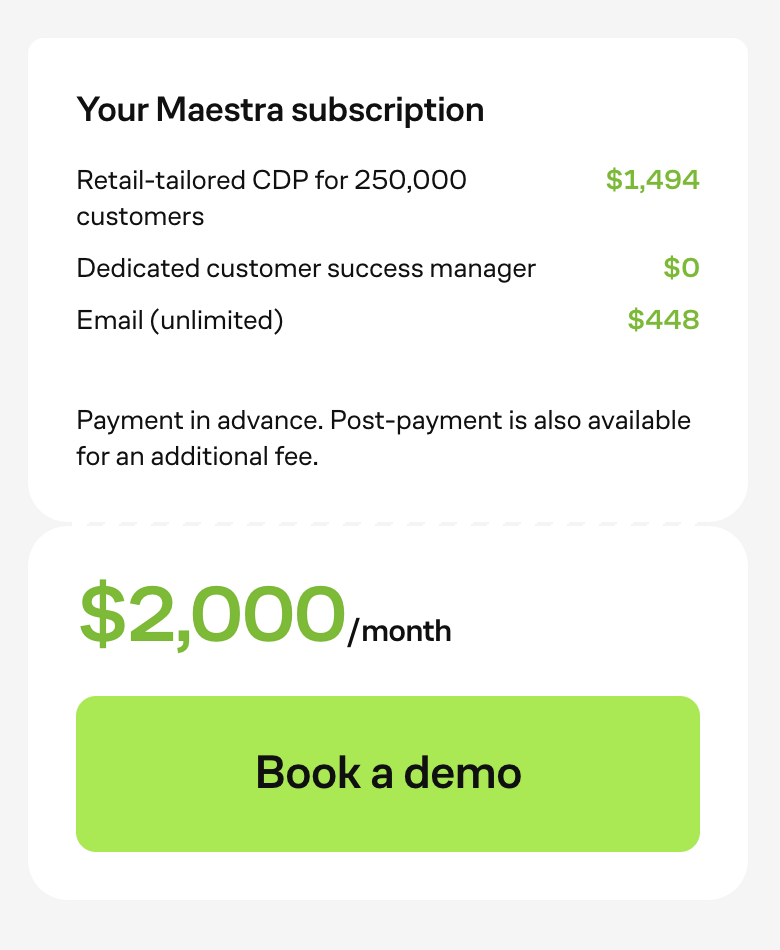
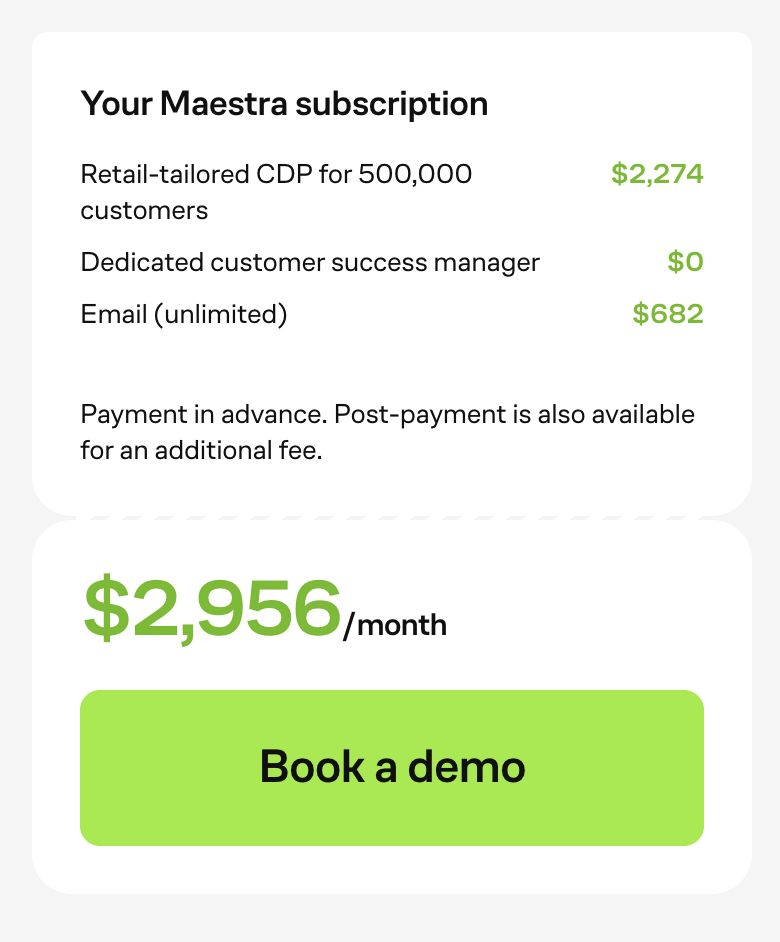
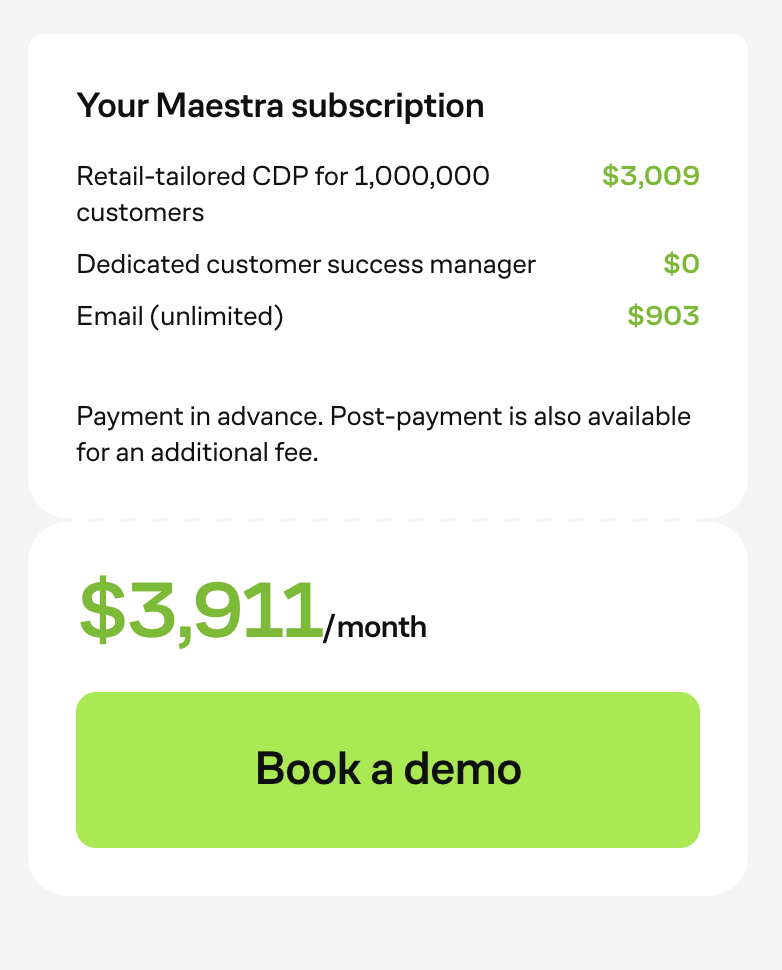
Price comparison for a Maestra subscription for 250,000, 500,000 and 1,000,000 customer profiles. Cleansing the database by removing inactive customers can help save on marketing costs
Fashion brand TOPTOP, for instance, sends reminders to customers who haven’t opened emails two, three, and four months since the last email interaction. If a customer does not make a purchase within four months, they are unsubscribed from email marketing campaigns. Two weeks later, those who have never made a purchase are automatically deleted from the database, ensuring marketing budgets are not wasted on storing and communicating with inactive contacts.
Improve Company Reputation with Email Services
The effectiveness of any email marketing strategy hinges on the sender’s reputation. Postmasters — services provided by email providers that track email delivery and spam complaints — help monitor the reputation of a domain and IP address. High engagement rates bolster your standing with email service providers, enhancing deliverability. Conversely, if customers stop opening a company’s emails, its reputation suffers, increasing the risk of being marked as spam and blacklisted. Emails from blacklisted senders may not be delivered even to clients who previously read them, hindering the brand’s ability to reach engaged subscribers.
Regularly engaging with your audience through winback emails not only helps in keeping your list clean but also ensures your emails continue to reach those interested in your brand.
When Should You Send a Winback Email?
Timing is crucial when it comes to sending customers winback emails. The objective is to re-engage customers who have stopped performing actions such as making purchases, visiting your website, logging into their accounts, or opening newsletters. The window for initiating reactivation ranges broadly from seven days to one year, depending on your business model and the typical frequency of customer interactions. Here are some examples based on different business models of Maestra’s clients:
- Travel Affiliate Network Travelpayouts sends winback emails to users who haven’t logged into their accounts between 7 and 30 days.
- DIY Retail Chain Axon targets customers who haven’t opened emails in 120 days or haven’t made a purchase in 90 days.
- An online supermarket re-engages customers who have made at least three orders in the past but haven’t purchased anything in the last 45 days.
Certain business models naturally expect longer intervals between customer engagements — one example is real estate development, where clients are not likely to return for another purchase within a month or even a year. It’s important to use a customized approach, testing different strategies to refine the timing of winback campaigns.
Identifying the Optimal Winback Reactivation Period
This period marks the time from when the initial reactivation attempt is made to the point a customer is either re-engaged or removed from the active database. Statistics from Maestra’s clients suggest that 90% of emails are opened within the first three days of sending. However, the decision-making process, from opening an email to making a purchase, varies significantly among companies.
Determining the exact reactivation period can be challenging, as even intuitively correct conclusions can turn out to be wrong. For example, the marketing team of one of our clients, a grocery chain, assumed that customers would use promo codes within the first two days after receiving a winback email.
This hypothesis was only partially confirmed: some buyers did use the promo codes within that timeframe, while others used them after one or two weeks. This is due to the fact that some people buy groceries daily, while others shop weekly. Even if subscribers receive a promo code now, they will still go shopping on the day they usually do their food shop because their refrigerator is likely to be full. This means that the reactivation period is not two days, but one or two weeks in this particular case.
Continuously testing and analyzing customer data to identify the most effective timing for winback emails is essential. What works for one business may not work for another, so the key here is to tailor your strategy to match your unique customer purchase cycle and engagement patterns.
We determined that the optimal timing for our first reactivation email was 60 days, based on extensive A/B testing prior to integrating with Maestra. Using its analytics and the basic RFM model, we found the average purchase interval to be two months — a year ago, recognizing this would have significantly reduced our efforts.
When Should You Avoid Sending Customers Winback Emails?
While the impulse might be to try and re-engage every lapsed customer, there are certain situations where initiating a winback campaign might not be the best use of resources. Understanding when to pause and reassess can help optimize your efforts and respect the customer’s boundaries. Here are scenarios where it might be wise to avoid sending a winback email:
Sometimes, a customer’s dissatisfaction stems from missing features or an inconvenient interface. Addressing these issues requires understanding whether the feature is truly essential for the client and how it integrates into their use cases. Evaluate how you can measure the effect and what the client’s expectations are. Often, you can find alternative solutions to fulfill the needed function or circumvent interface issues. If a feature change is crucial for the client, it may be worth incorporating this into your product development plan.
1. Customers Who Have Explicitly Opted Out
If a customer has clearly expressed disinterest in receiving emails or using your services, it’s critical to respect their wishes, especially in the B2C (Business-to-Consumer) sector. For B2B (Business-to-Business) relationships, there might be room to inquire further about the specific reasons for their disinterest — sometimes, the issue could be as simple as misunderstanding a product’s features or functionality. A targeted effort to address their concerns or educate them about the product might rekindle their interest.
2. Customers Who Have “Outgrown” Your Brand’s Offering
For instance, a children’s clothing brand designed for ages up to 10 won’t serve customers once their children grow older. In such cases, attempting to win back customers would be ineffective since your product range no longer meets their evolving needs.
Segmenting Your Customer Base for Winback Emails
Effective segmentation is a cornerstone of an effective winback campaign, ensuring your message lands in the right inbox. Before jumping into segmentation, it’s vital to consolidate all customer data in one place and define your reactivation goals to accurately identify relevant segments.
Consolidating Customer Data
If your customer data is scattered across multiple databases — for instance, online, offline, and mobile purchases — it can lead to inaccurate segmentation. A customer who shops in-store but is only recorded in the online purchase database might mistakenly be selected for reactivation, receiving messages like “we miss you, ” despite just having made an in-store purchase. This not only wastes company resources but can also frustrate customers with irrelevant communications.
A unified marketing system such as Maestra can help avoid these pitfalls by centralizing data in comprehensive customer profiles. These include detailed purchase histories — online, in-store, via mobile apps and call center interactions — enabling precise segmentation for personalized campaigns and an accurate measurement of communication effectiveness.
Segmentation According to Reactivation Goals
Your reactivation goals with winback emails might include increasing sales or enhancing email engagement. Each goal requires prompting customers toward a specific action, whether that’s completing a purchase or clicking through to your site from an email.
Once the goal and the target customer action are defined, segmentation can begin. From your customer pool, identify individuals who have not engaged in the desired action for a while. For instance, a clothing store aiming to increase sales would segment out customers who haven’t purchased anything in the last two months despite being frequent buyers in the past.
To improve email open rates, focus on a segment that has the lowest open rate. Here, purchase behavior is irrelevant — the segment can be defined by criteria such as “hasn’t opened any newsletters over the past X days.”
In some cases, businesses need users to simply start reopening emails. One tactic is to inform customers they will be removed from the mailing list. This method can be surprisingly effective as it taps into the desire to remain connected with the brand.
To win back customers who have stopped purchasing, you can segment customers whose purchase frequency has decreased significantly or who haven’t made a purchase longer than other customers on average. This group might still interact with your content or browse your website. Their segment definition could be “no purchases in the past X days.” RFM (Recency, Frequency, Monetary) analysis can be particularly useful here, as it evaluates the recency and frequency of purchases and the monetary value of each customer.
Winback reactivation campaigns can also be more targeted, like aiming to win back high-value customers. This segment is crucial because it significantly impacts company revenue. To segment these customers, select a broad “no purchase in the past X weeks/months” segment and filter customers with a “high average order value.” In tools like Maestra, this can be done using the built-in RFM report or manually with segment conditions. These act as filters and allow you to segment customers by almost any parameter: frequency, purchase history, average order value, and even views of specific products. Campaigns with precise segments like these are likely to show high conversion rates.
Winback Reactivation Strategies
In essence, there are two key approaches that you can use to win back disengaged customers:
1. Temporarily Exclude Inactive Customers from Regular Communications
According to a study by Optimove, 66% of consumers report they would prefer to receive less emails, and 27% feel bombarded by email marketing. Temporarily excluding inactive customers is a strategy that hinges on the principle of less is more, avoiding overwhelming the customer, which can help reignite their interest. The key is to curate only the most compelling content for infrequent communication. This might mean limiting contact to the most enticing offers or important updates once a month, increasing the likelihood that these communications are welcomed and read.
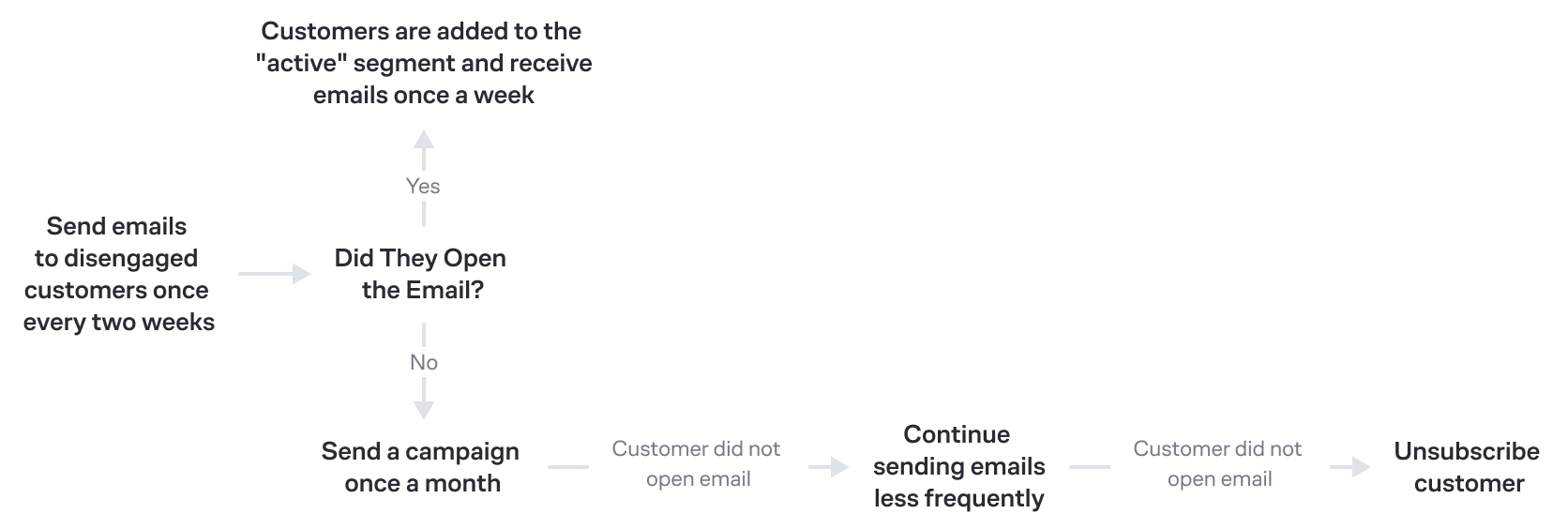
An example of a "less is more" email reactivation strategy from one of Maestra’s clients
When a customer hasn’t interacted with emails for an extended period, we limit their exposure to our regular email flow. They’re reserved for our most engaging offers. This approach has been effective in reactivating dormant segments and helps us understand what truly resonates with our audience.
2. Send Targeted Winback Emails
The primary goal of targeted reactivation campaigns is to reawaken the customer’s interest in your brand. Start by postulating why they might have disengaged and then craft varying types of email campaigns to test these theories.
Best Winback Email Campaign Types and Examples
Here are some winback campaign types that have proven effective with examples from Maestra’s clients:
NPS Surveys
A study carried out by the SAS Institute found that 89% of customers will ditch a company after several poor service experiences, and a third will leave after just one. An NPS (Net Promoter Score) survey can help identify customer dissatisfaction. When a company suspects a decline in service quality or product satisfaction, querying customers with an NPS survey can offer insights that lead to improvements. Offering incentives, such as a discount or gift for participating, can increase the response rate.
One of Maestra’s clients, a publishing group, noticed a drop in their newsletter open rate and conducted a survey that allowed for open-ended comments. Customers indicated a desire to preview book excerpts, which the company then included in their newsletters. This adjustment led to an increase in both open rates and sales.
Clothing brand, 12 Storeez, reached out to customers who hadn’t engaged with their emails for six months, asking for feedback on their dissatisfaction. Even though the survey did not direct respondents to the store, it reignited customer interest in the brand, resulting in 28 orders from a segment that had been inactive for half a year:
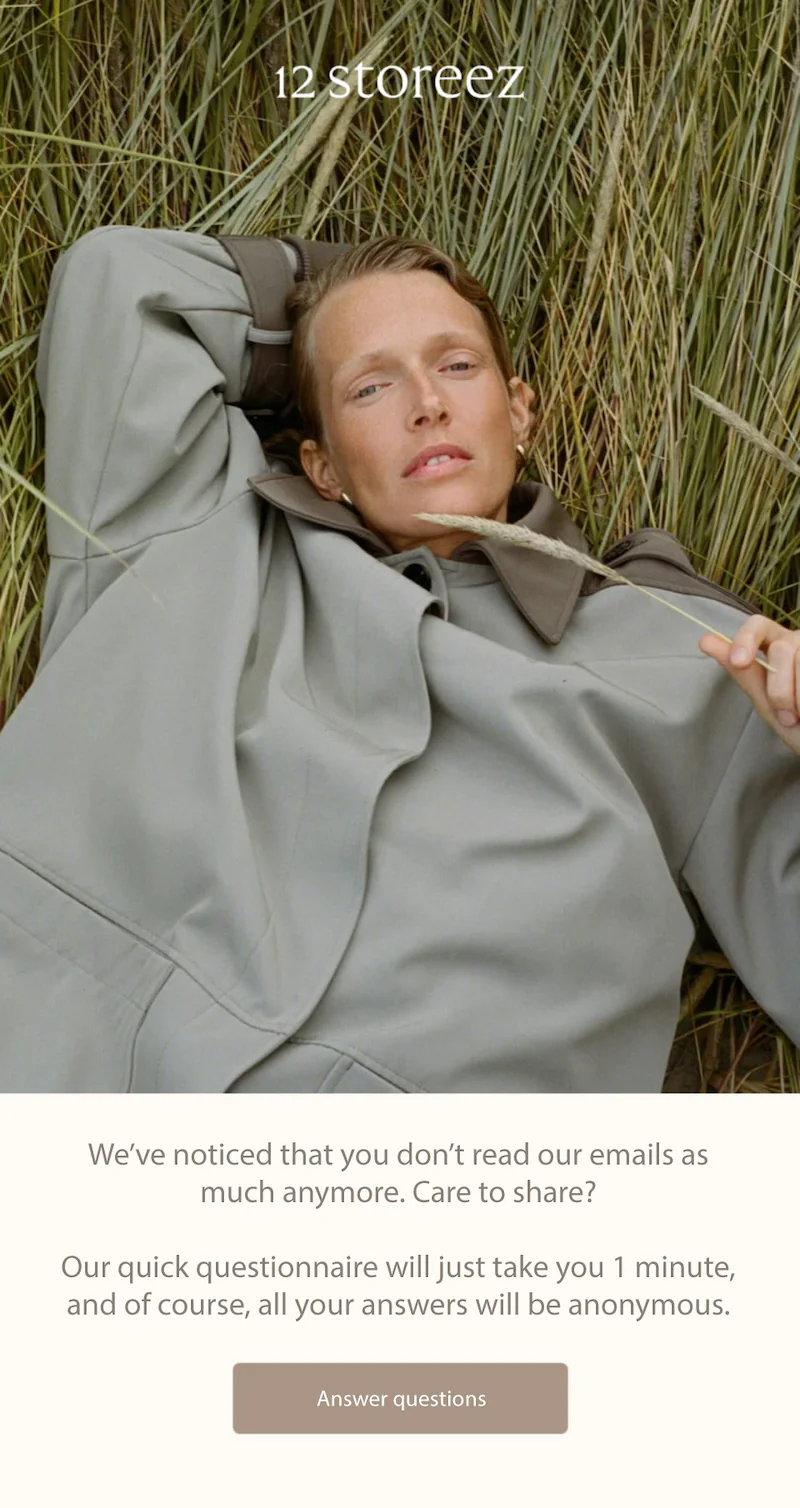
NPS campaign received by 12 Storeez customers who had been inactive over six months
Discounts or Promo Codes
Discounts and promo codes are often the centerpiece of winback campaigns, particularly when addressing concerns about pricing. Here’s how they can be integrated effectively:
Testing Price Sensitivity
If there’s a suspicion that customers have drifted due to pricing, a winback email offering a discount or a promo code can serve as a litmus test. By monitoring the uptick in returning customers, you can assess the validity of the price sensitivity hypothesis.

FOAM’s winback email offers a 15% discount on products and contains recommendations to draw customers back to the website
Strategic Discount Sequences
Rather than presenting the steepest discount upfront, consider a series of emails that offer incremental discounts. This strategy not only re-engages customers but also helps determine the most cost-effective discount level that prompts a purchase.
Promo Codes for Free Shipping
Including a promo code for free shipping can be particularly effective, as shipping costs are a common barrier to completing an online purchase. Free shipping offers are tangible and immediately beneficial, which can be a strong incentive for customers to revisit their abandoned carts or browse new items.
When coming up with your discount margin, consider testing different options with your audience. Maestra’s client, a wine supermarket chain, experimented with varying discount levels through an A/B testing approach. They discovered that offering 5% and 7% discounts yielded a similar rate of customer return. This indicates that the presence of a discount, rather than its magnitude, is often the key motivator for customers contemplating a return.
Curated Product Recommendations
Customers may not be aware of the full range of products available. A winback strategy could include an email with personalized recommendations based on the customer’s purchase history, items that are popular among other customers, or items they have shown interest in. For example, a customer who bought a coat may not always consider that they could also purchase a matching scarf or gloves. One of Maestra’s clients, a retail chain, tested personalized recommendations in their emails to lapsed customers and found that those who received the email were 1.9% more likely to make a purchase than those who did not.
Flower delivery service, Blossom Flower, combines product recommendations and personalized discounts to win back customers:

A sample of Blossom’s reactivation email
Emotional Re-Engagement Emails
The essence of a successful winback strategy often lies in its ability to forge an emotional connection. Emails that say “we miss you” or “thinking of you” strike a chord, reminding customers that their absence is felt. These communications convey a sense of personal value and recognition that goes beyond the standard customer-company relationship. They let the customer know they’re not just another statistic but a valued member of your community.
An effective emotional re-engagement email accomplishes several critical goals:
- Revives the Customer’s Connection: It brings back the reasons they chose your brand, highlighting the emotional or practical benefits that drew them in.
- Demonstrates Value and Benefits: It outlines what your brand offers, showcasing not just the features but the benefits that enhance their life or solve their problems.
- Acknowledges and Appreciates Loyalty: It makes customers feel seen, recognized, and appreciated, reinforcing that their loyalty is not taken for granted.
- Keeps Your Brand Top of Mind: It ensures that when customers are ready to engage again, your brand is the first they think of, thanks to the positive and personalized reminder.
Winback Campaign Series
In many instances, one-off winback attempts may not be sufficient to re-engage customers. A series of carefully crafted and well-timed emails can be more effective, especially when they form part of a strategic marketing flow. This approach holds true for a variety of businesses, particularly those offering high-value items or services that require thoughtful consideration. It nurtures a relationship over time, providing multiple touchpoints that can guide the customer back to your brand. Here’s how a structured winback campaign series can make a significant difference:
- Initial Outreach: Send an initial email to acknowledge the customer’s absence and express that they’ve been missed. Offer a glimpse of what’s new or improved since their last interaction.
- Follow-Up with Value: After the initial outreach, the next email could provide value, such as helpful information, tips, or insights related to products they’ve shown interest in.
- Personalized Offers: Subsequent emails might include personalized offers or discounts tailored to their purchase history or items they’ve browsed.
- Feedback and Engagement: Later in the series, seek feedback or conduct a survey to understand their needs better and demonstrate that their opinion shapes your offerings.
For example, one of Maestra’s clients, a real estate service, acknowledges that choosing a property is not a snap decision. Instead of pushing for quick sales, they position themselves as a helpful resource throughout the customer’s decision-making journey. Potential homebuyers are segmented based on their interests and interaction history. This ensures that each recipient gets content that resonates with their specific real estate needs, such as:
- Customers interested in country properties receive suitable listings or articles on the benefits of countryside living.
- Customers eyeing new developments receive timely updates or alerts about the availability, encouraging them to act before it’s too late.
How to Create a Winback Email Campaign
Here’s a step-by-step guide to reactivating customers using winback emails, along with practical tips to make your campaigns more effective.
- Consolidate Customer Data: Gather all customer data in one place to avoid sending conflicting messages to clients who are active in different sales channels.
- Segment Your Customer Base: Utilize RFM (Recency, Frequency, Monetary) analysis or CDP filters to segment customers for reactivation based on their past interactions with your brand.
- Tailor Reactivation Tactics: Choose a reactivation method tailored to the reason a customer has become inactive:
• Product Dissatisfaction: If the product didn’t meet the customer’s needs due to lack of functionality or an inconvenient interface, offer personalized assistance from a manager to help configure the product, or create guides and video tutorials explaining the product’s value.
• Price Concerns: When prices are higher than competitors, send discount codes and promos to make your pricing more attractive.
• Poor Service Experience: Address issues like delayed delivery or unresponsive customer service by apologizing and compensating the customer with free shipping or a discount on the next purchase.
Additional Tips for Reactivation Campaigns:
Keep It Short: Craft concise and direct messages. Customers appreciate brevity, especially if they’re short on time.
Use an Enticing Subject Line: Your winback subject line is your first impression. Make it count by arousing curiosity or offering clear value.
Incorporate Feedback: Regularly enhance your products and processes by asking for and implementing customer feedback to improve their overall experience.
Value-Adding Propositions: Enhance the product’s appeal with additional options like free shipping or a gift with their order.
Measuring Success and Iterating
Understanding the effectiveness of your winback campaigns is crucial for refining your strategy and maximizing the number of customers that return. A/B testing plays a pivotal role in this process, allowing you to determine the most impactful content and the optimal discount level for re-engaging customers. These tests are typically conducted using control groups, allowing for a clear comparison between different campaign variations. Once the most effective version is identified, it can be rolled out across the entire customer base.
One example is family clothing brand Mark Formelle, where the team experimented with different types of product recommendations in their winback emails. One group received generic recommendations, such as a selection of t-shirts for men and swimsuits for women. The other group was sent personalized recommendations generated through machine learning algorithms. The personalized approach significantly outperformed the generic one, demonstrating the power of tailored content.
Final Thoughts
Winback email campaigns are a crucial strategy for businesses looking to re-engage with customers who have become less active over time. These campaigns go beyond the realm of standard marketing practices by creating a sense of personal connection and reiterating the value a brand places on each individual customer. The ultimate aim is to leverage a pre-existing customer relationship and strengthen it, which can lead to increased engagement and, consequently, higher revenue.
The effectiveness of winback emails lies in their ability to feel personalized rather than purely promotional. By utilizing data analytics, brands can determine the most appropriate time to reach out to each customer, delivering content that is relevant to their past behavior and current interests. This strategic approach, combined with compelling incentives, is designed to increase the chances of re-engaging the customer.
At the same time, it’s important to understand that, just as with any other marketing campaign, the process of creating successful winback emails is iterative and demands constant refinement. It involves an ongoing cycle of testing, measuring, and adapting. Businesses must continuously analyze the performance of these campaigns, conduct A/B testing to understand what resonates with the audience, and refine their approach based on these insights. This not only enhances the immediate effectiveness of individual campaigns but also contributes to a deeper understanding of customer behavior, which is essential for long-term engagement and retention strategies.






